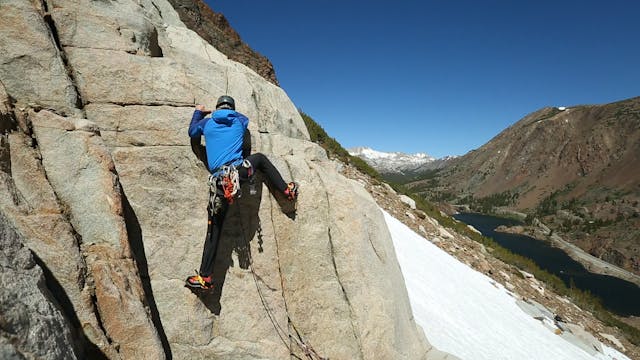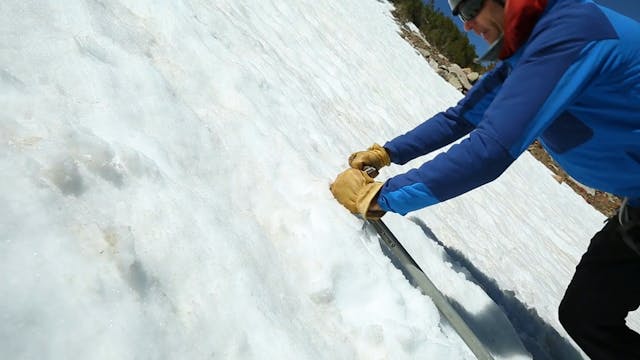Alpine: 18. Selecting Ice Axes & Ics Tools
Alpine & Mountaineering
•
5m 43s
Here we depict different styles of ice axes and “ice tools”. Selection factors include specific climbing objectives, and the conditions one plans to encounter while in the mountains.
Main factors to consider when selecting ice axes or ice tools include:
- Conditions
- Firmness of the snow
- Severity of the climb
Let’s start by looking at ice axes suitable for softer snow, and less steep terrain -
1. Classic Mountaineering Ice Axe:
- Includes a large head, with an adze and large pick
- Includes a longer shaft
- The shaft features a spiked bottom end, suitable for deeply penetrating soft snow
- This is an old-school classic, good for general mountaineering or perhaps ski mountaineering
2. Modern Mountaineering Ice Axe - Long Length:
- Features a lighter weight aluminum shaft
- Still long enough for powdery snow or lighter snow conditions
- Large adze for chopping steps, chopping ice, or generally shoveling snow out of the way
- Also good for softer snow travel
3. Modern Mountaineering Ice Axe - Medium Length:
- The all-arounder
- This medium length has the benefits of a modern ice axe, in a tidier package
- This axe is effective if uncertain which conditions might be encountered during general mountaineering
- Shorter people appreciate this medium length
- Lighter weight aluminum shaft than the old-school classic mountaineering axes
- Still long enough for powdery snow or lighter snow conditions
- Large adze for chopping steps, chopping ice, or generally shoveling snow out of the way
- Good for softer snow travel
Now let’s look at technical ice axes, which are typically called “ice tools”. These weapons of choice are best suited for harder snow, waterfall ice, and steeper terrain -
4. Hybrid Tools:
This is a mix between a traditional mountaineering axe, and an ice climbing tool
- Similar to ice tools, the hybrid often has a hammer on one end, instead of an adze
- The hammer is for pounding in pitons or snow pickets, and knocking away snow pillars
- A hammer style ice tool is often safer than an ice tool with an adze, in case the ice tool inadvertently pops out of the ice towards your face. Either way would hurt your face, but a shiner bruise is better than a giant skin flap!
- Great for several conditions, from snow climbing to vertical waterfall ice
5. Technical ice climbing tools:
- Typically reserved for vertical waterfall ice climbing, or “mixed” climbing (i.e. rock and ice)
- Shorter than a traditional mountaineering axe
- Features a curved shaft
- Provides grip rests at the middle and/or bottom of the shaft for ice climbing “leashless”
- Reverse curve pick for improved ice penetration and grip
- Here we showcase the Black Diamond Cobra ice climbing tool. This has become a preferred ice tool for over 10 years. The BD Cobra ice tool combines a smooth and streamlined shape, plus an ideal balance and swing, in a handsome carbon fiber package
Looking across the spectrum of ice axes and ice tools, you will notice most (if not all) axes and tools no longer have leashes or wrist loops. During long mountain travel, an ice axe is often transferred between hands, depending on the directions a climber travels up the slope. A leash makes it slower or harder to transfer the ice axe between hands. This process of unstrapping and transferring the leash wastes valuable energy.
However, in the case of multi-pitch ice climbing, it can be a good idea to use a tether such as the spinner leash from Black Diamond for your ice tools. This device connects to your harness, and individually clips in to your ice tools. This is great for keeping your tools from being dropped, but they are NOT suitable for anchor or belaying purposes.
We hope you found this video helpful. Do you have a favorite ice axe or ice tools? Feel free to comment below with questions or thoughts!
Please remember, climbing is inherently dangerous. Climb at your own risk.
Up Next in Alpine & Mountaineering
-
Alpine: 19. Clothing Considerations
How do you dress for all the possible conditions you might encounter on an alpine climbing mission? In this video, we dive into layering clothes for alpine pursuits. You’ll notice that the clothes work as a system based on layers, that pack easily, dry fast, and that you can add or remove based o...
-
Alpine: 20. Staying Dry and Warm
In this video we talk about staying dry and warm in the mountain environment. Specifically, we will address layering and eating food.
Layering Clothes:
As in most outdoor sports, layering for activity is essential. With alpinism, one moves from periods of high exertion (where you expend hug...
-
Alpine: 21. Food & Water Considerations
In this video we discuss food and water options for mountaineering.
People often default to dehydrated packaged meals, but they can take a very long time to rehydrate at higher elevations, and above 15,000 feet some companies say you will have to boil the meal for as long as 20 minutes.
Re...


